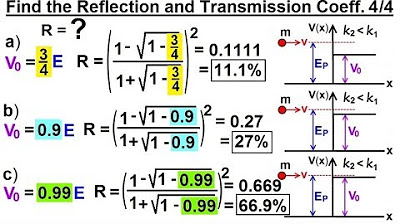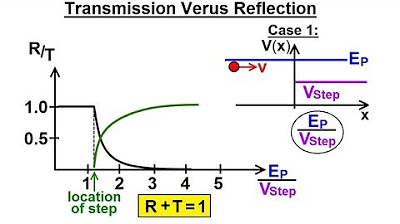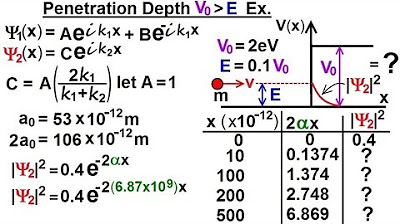Physics - Ch 66 Ch 4 Quantum Mechanics: Schrodinger Eqn (73 of 92) R=? T=? V0=(1/2)E (Ex. 3 of 4)
TLDRThis video script delves into the behavior of particles encountering a potential step energy barrier. It explores how the reflection coefficient changes when the step potential increases from 1/4 to 1/2 the energy of the particle. The script simplifies the equation for easier calculation and reveals a surprising result: with the potential step at half the particle's energy, nearly 3% of particles are reflected, while 97.05% are transmitted. This insight prompts further investigation as the potential step approaches the particle's energy.
Takeaways
- 📈 The reflection coefficient significantly increases when the step potential is half the energy of the particle.
- 🔢 At a step potential of 1/2 the particle's energy, the reflection coefficient is approximately 2.95%.
- 🔄 When the step potential is 1/4 the energy of the particle, the reflection coefficient is about 0.5%.
- 🧠 The script introduces a simplified equation to calculate the reflection coefficient based on the energy ratio of the potential step to the particle.
- 🌟 The transmission coefficient (T) is calculated as one minus the reflection coefficient (R).
- 🚀 With a step potential of 1/2 the particle's energy, 97.05% of the particles are transmitted.
- 📌 The script suggests that as the potential step approaches the energy of the particle, the reflection and transmission coefficients change significantly.
- 📑 The mathematical derivation in the script simplifies the process of calculating the reflection coefficient for different energy ratios.
- 🎯 The script provides a practical example of calculating the reflection coefficient when the step potential is 1/2 the energy of the particle.
- 📈 The results show a surprising outcome that even with a potential step equal to half the particle's energy, the majority of particles still get transmitted.
- 🔍 The script encourages further exploration as the potential step becomes larger, promising more examples to understand the behavior of particles in such conditions.
Q & A
What is the significance of the reflection coefficient in the context of the video?
-The reflection coefficient is a measure of the percentage of particles that are reflected by a potential step when they have a certain energy. It's important in understanding how particles interact with potential barriers or steps.
What happens to the reflection coefficient when the step potential is 1/4 the energy of the particle?
-When the step potential is 1/4 the energy of the particle, the reflection coefficient is very tiny, indicating a very small percentage of particles are reflected.
How does the reflection coefficient change when the step potential becomes 1/2 the energy of the particle?
-When the step potential is 1/2 the energy of the particle, the reflection coefficient increases to almost 3%, which is a significant increase from when the potential was 1/4 the particle's energy.
What is the transmission coefficient (T) in relation to the reflection coefficient (R)?
-The transmission coefficient (T) is equal to one minus the reflection coefficient (R), indicating the percentage of particles that get transmitted through the potential step.
What is the simplified form of the equation for the reflection coefficient when the step potential is 1/2 the energy of the particle?
-The simplified form of the equation is R = (1 - sqrt(1/2)) / (1 + sqrt(1/2))^2, which makes it easier to calculate the reflection coefficient for different step potentials.
What is the percentage of particles reflected when the step potential is 1/2 the energy of the particle?
-When the step potential is 1/2 the energy of the particle, approximately 2.95% of the particles are reflected.
What percentage of particles are transmitted when the step potential is 1/2 the energy of the particle?
-When the step potential is 1/2 the energy of the particle, approximately 97.05% of the particles are transmitted.
How does the script suggest the relationship between the energy of the potential step and the reflection coefficient?
-The script suggests that as the energy of the potential step increases relative to the energy of the particle, the reflection coefficient also increases, meaning more particles are reflected.
What is the purpose of simplifying the equation for the reflection coefficient?
-The purpose of simplifying the equation is to make it easier to work with and calculate the reflection coefficient for different values of the potential step relative to the particle's energy.
What is the next step suggested in the video script for further exploration?
-The next step suggested is to explore what happens when the potential step becomes even larger, approaching the value of the energy of the particle, to understand the behavior of the reflection and transmission coefficients in those conditions.
Outlines
🔬 Exploring Particle Reflection at Different Energy Levels
This paragraph delves into the behavior of particle reflection at varying energy levels. It begins by revisiting previous discussions on the reflection coefficient being minimal when the step potential is a quarter of the particle's energy. The focus then shifts to examining the scenario where the step potential is half the energy of the particle, questioning the impact on the reflection percentage. The paragraph also introduces an attempt to simplify the equation for easier calculation, starting with plugging in the value of 1/2 e for VSIP naught and simplifying the resulting equation. The discussion concludes with a calculation that shows approximately 2.95% of particles are reflected when the potential step is half the energy of the particle, significantly higher than when the potential was a quarter of the particle's energy.
Mindmap
Keywords
💡Reflection Coefficient
💡Step Potential
💡Transmission Coefficient
💡Particle Energy
💡Simplification of Equations
💡Quantum Mechanics
💡Potential Energy
💡Sqrt Function
💡Factoring
💡Calculus
💡Energy Conservation
Highlights
The reflection coefficient is very tiny when the step potential is 1/4 the energy of the particle.
The step potential now becomes 1/2 the energy of the particle.
The reflection coefficient will be a larger percentage when the step potential is 1/2 the energy of the particle.
The equation for the reflection coefficient is being simplified for easier calculation.
By plugging in 1/2 e for VSIP naught, the equation is simplified.
The simplified equation is easier to use without having to go through complex simplification steps.
The fraction of the energy that the potential step has relative to the energy of the particle is directly input into the equation.
The reflection coefficient increases to almost 3% when the potential step is 1/2 the energy of the particle.
The transmission coefficient T is equal to one minus the reflection coefficient R.
When the potential step is 1/2 the energy of the particle, 97.05% of the particles get transmitted.
The potential step being half the energy of the particle results in a surprising outcome with only about 3% of particles reflected.
The experiment aims to explore what happens as the potential step approaches the value of the energy of the particle.
A more fine-tuned or simplistic form of the equation is sought for better understanding and application.
The video provides a practical application of the equation in calculating the reflection and transmission coefficients.
The results show a significant increase in the reflection coefficient as the potential step's energy increases.
The video content is valuable for those interested in quantum mechanics and particle physics.
Transcripts
Browse More Related Video

Physics - Ch 66 Ch 4 Quantum Mechanics: Schrodinger Eqn (74 of 92) R=? T=? V0=(3/4)E,.(Ex. 4 of 4)

Physics - Ch 66 Ch 4 Quantum Mechanics: Schrodinger Eqn (62 of 92) Transmission vs Reflection

Physics - Ch 66 Ch 4 Quantum Mechanics: Schrodinger Eqn (72 of 92) R=? T=? V0=(1/4)E (Ex. 2 of 4)

Physics - Ch 66 Ch 4 Quantum Mechanics: Schrodinger Eqn (71 of 92) R=? T=? V0=(1/4)E (Ex. 1 of 4)

Physics - Ch 66 Ch 4 Quantum Mechanics: Schrodinger Eqn (76 of 92) Penetration Depth V0, E: Ex.

Physics - Ch 66 Ch 4 Quantum Mechanics: Schrodinger Eqn (67 of 92) Finding R=? T=? Coefficients
5.0 / 5 (0 votes)
Thanks for rating: